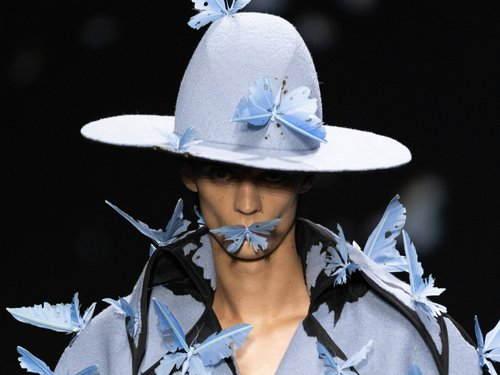Sunday, 25 August 2024
Butterfly Couture A/W 2024
Sunday, 18 August 2024
Tavares Strachan: There Is Light Somewhere
Bahamian artist Tavares Strachan's work first came to my attention with his colossal First Supper (Black Galaxy) sculpture installation which reimagined Leonardo's Last Supper with historical black figures in the courtyard of the Royal Academy as part of their Entangled Pasts show (here) earlier this year. It made a dramatic impact and wanting to discover more about Strachan and his art, I jumped at the chance to visit this solo retrospective at the Southbank's Hayward Gallery. Strachan is a really interesting multi-disciplinary artist who, in the name of his art, has walked to the north pole, following in the footsteps of Black polar explorer Matthew Henson, and taken a block of arctic ice back to the Bahamas. He has also trained as an astronaut in Russia and blasted a sugarcane-fuelled rocket into the stratosphere, as part of a programme to interest young Bahamians in science and technology. Strachan has also produced his own encyclopedia - The Encyclopedia of Invisibility from 2018, which is a staggeringly ambitious project containing roughly 17,000 entries addressing mainly black figures who have been erased or under-celebrated in Western history. This theme runs throughout much of Strachan's work. Visitors approaching the Hayward are met with a large neon sign installed on the facade of the building which reads "You belong here". The artist questions this sense of belonging, placement and exploration with the artworks displayed within the gallery spaces. Also placed outside is a gargantuan head of a young Marcus Garvey which was immediately reminiscent to me of those colossal, stone Olmec heads discovered in the jungles of Mexico. More of these large, bronze heads feature throughout the show but are more recognisable as African American activist and abolitionist Harriet Tubman, and legendary dub music producer King Tubby. There are are other, smaller portrait heads which sit atop ceramic vases which open up to reveal characters (Nina Simone/The Queen of Sheba) from history layered beneath their surfaces. One of Strachan's strengths is his ability to easily shift between media and use whichever best suits his vision for a project. There is traditional bronze for the sculptures, ceramics as mentioned, neon, photography, tapestry, paint and even human hair. The first room features a series of collaged paintings which are visual equivalents of free-form jazz or dub music. They are visually rich, incongruous mash-ups of figures from history such as Queen Elizabeth II and Haile Selassie, flora and fauna, diagrams, space and technology. This assault on the senses continues in the next part of the exhibition which houses Strachan's impressive -Encyclopedia of Invisibility. Densely presented words and pictures assail you before you move on to two quieter, ghostly perspex boxes filled with mineral oil in which sit ghostly Pyrex glass figurative sculptures, one of which contains an effigy of Henrietta Lacks, a black woman who became famous when medical staff discovered that her cell line could grow and divide endlessly in a laboratory leading scientists to label them "immortal". Lacks' cells were taken without her knowledge or consent, and these cells still continue to fuel medical research years after her death. I also admired Strachan's neon text works, and the stunningly beautiful Pyrex glass sculpture Robert, another neon piece based on the nervous system of first black astronaut Robert Henry Lawrence Jr. The next impressive gallery of artwork is upstairs which houses the giant-sized head of King Tubby and a large, thatched grass hut installation appropriately titled Intergalactic Palace, inspired by the structures where the ruling kings (kabakas) have been crowned in Uganda’s Kingdom of Buganda since the 14th century. In this futuristic space lined with pulsing lights and sheet music hanging from the walls, sits a golden DJ deck which plays the light and sound installation Sonic Encyclopedia. The floor of this gallery is textured with a rich, red, iron oxide dust possibly meant to be evocative of areas of East Africa where such minerals are mined and the surface of Mars. Another rather incongruous surprise is found if one steps out onto the roof terrace of the Hayward Gallery which has been flooded with water and sound to create a pool, on which pointing towards Africa floats a replica of the ship SS Yarmouth – the flagship of the Jamaican pan-Africanist Marcus Garvey’s utopian Black Star Line project, which would return African American people back to their liberated ancestral homeland. I don't understand why Strachan's work wasn't included in the excellent In the Black Fantastic exhibition (here) also staged at the Hayward two years ago, as it would have been a perfect fit with its themes of Afrofuturism. There is so much to take in here, and scope for further themes and ideas to be mined intersecting black history, science, and politics by the ambitious and imaginative Strachan. This is ultimately a rewarding exhibition enhancing viewers knowledge in all things Afrocentric historically, but also looks forward to Afrofuturistic possibilities in technology, life and travel for people of colour beyond this earth. Amazingly this is the first ever major museum survey anywhere of Strachan's work. Given the vision, depth, ambition and scale of his work I am certain it will not be his last.






























































































